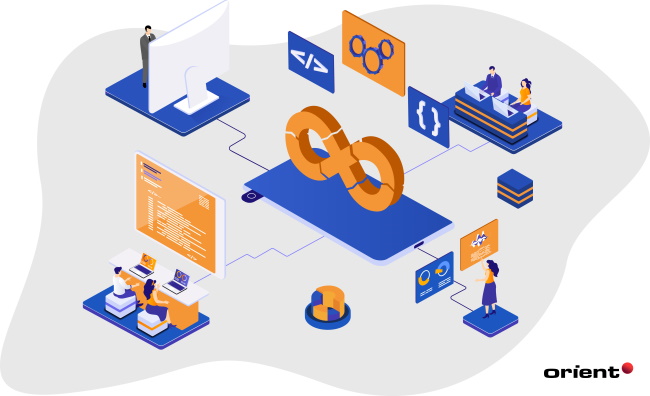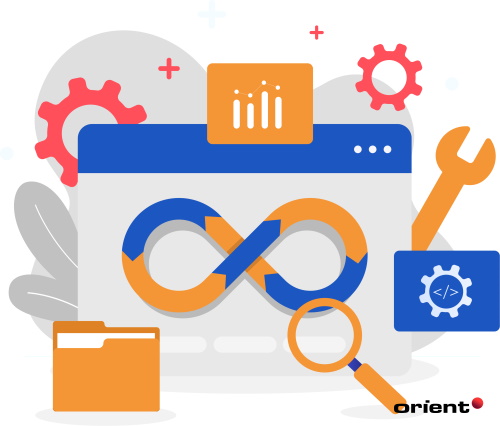Here are the Best Tools to Manage Each Phase of the DevOps Lifecycle

Content Map
More chaptersDevOps is a combination of the terms ‘Development’ and ‘Operations.’ The purpose of DevOps is to streamline the software development cycle by improving communication and collaboration between the Software Development and IT Operations teams. This is achieved by implementing continuous feedback into each phase, from planning and building to testing, deployment, and monitoring.
With the DevOps model, companies can release higher quality software and updates faster, on a more frequent basis. And the use of DevOps lifecycle tools helps improve team collaboration and introduces automation to speed up development and reduce time to market, keeping the company competitive.
Breaking Down the DevOps Lifecycle
The DevOps lifecycle consists of various stages, where each stage contributes to the successful launch – and post-launch support – of a software product.
Each stage also implements continuous feedback into the process, which helps both the Development and IT Operations teams get a deeper understanding of how each stage is going, how it is contributing to the development cycle, and what steps must be taken to address any potential bugs, issues, or errors.
With this in mind, let’s dive deep into each stage of the DevOps cycle, and the kind of tools that companies use in order to successfully complete each stage.
Continuous Development
The development stage involves planning and coding the software. The two teams work together to understand the client’s vision and build the code necessary to help bring that vision to life. In most cases, tools are used to maintain the code and not to build the code.
Some of the most common code maintenance tools include Git, SVN, CVS, Jira, and Mercurial. DevOps lifecycle tools like Git are distributed version control tools, which support distributed non-linear workflows by providing data assurance for software development. Git for example enables the Development and Operations team to communicate seamlessly between one another and ensures that both teams always have a stable version of the code with them.
Continuous Integration
Continuous integration is one of the most important stages in the DevOps model. In this stage, the development team commits to changing the source code on a regular basis. These changes may occur on a weekly or monthly basis depending on the project scope.
The purpose of continuous integration is to make gradual improvements to the software by adding new functions and features. It also involves discovering and rectifying any bugs, errors, or issues that may cause problems later on. As a result of these changes, the software is more likely to be high performing, secure, compatible with a wider range of devices, and containing all the features that customers would expect from that type of software.
In order to fulfill the continuous integration stage, developers use a wide range of tools. Jenkins is one of the most popular DevOps lifecycle tools to use at this stage. How does Jenkins work? Simply put, whenever a change occurs in the Git depository, Jenkins collects the updated code and prepares a build of the code in an executable file – usually a WAR or JAR file – which the developers can then launch and test. Other popular continuous integration tools include Bamboo, Buddy, TeamCity, Travis, and CircleCI.
Continuous Testing
In this stage, software developers perform continuous testing to ensure the software meets the highest quality assurance. By testing early and often, developers can identify bugs and errors and rectify them early before they have a chance to creep up at the last minute or – even worse – show up after the product is launched.
These days, developers use a range of testing tools to speed up the process and produce the most accurate reports. Software testing tools like Selenium allow developers to perform automated testing across different browsers for web applications, while tools like TestNG are a simple, useful, and effective way to test software developed in the Java programming language.
Automation software testing tools help developers save time and effort on performing manual testing. It also enables them to perform testing on a more regular basis, thereby increasing the odds of achieving early bug and error detection. Developers can even schedule tests ahead of time to ensure the approach is continuous and consistent.
Continuous Monitoring
During the continuous monitoring stage, important information about the use of the software is recorded and processed to identify trends and patterns. For example, the development team may identify issues with software loading times, instances of poor performance, delayed user inputs, and more.
Through the use of continuous monitoring tools such as Nagios, Splunk, PagerDuty, and ELK Stack, developers can speed up the process and know exactly what issues need to be addressed to improve the quality of the software.
Nagios is an open-source computer-software application that is designed to monitor systems, networks, and server infrastructure. It performs periodic check-ups on critical parameters of an application, while alerting the user when a problem is found and then another alert when the problem is resolved.
Splunk is another popular continuous monitoring tool. It enables organizations to search, monitor, analyze, and visualize machine-generated big data that comes from websites, applications, servers, networks, sensors, and mobile devices. This helps organizations gain a deeper understanding of user trends and patterns, mitigate cyber security risks, and improve software performance.
Continuous Deployment
The continuous deployment stage is where the final code is deployed on all production servers. Companies that employ continuous deployment may release code or feature changes several times a day. The use of automation can help speed up and streamline this process, while the use of containerization tools can help ensure that code consistency is retained across different deployment platforms and environments.
Some of the most popular and efficient DevOps lifecycle tools used in continuous deployment are Chef, Puppet, Ansible, and SaltStack. Chef is a configuration management tool that enables developers to automate the deployment process, which streamlines application development, infrastructure configuration, and compliance auditing operations.
Ansible is another highly efficient open-source IT automation engine, which has the ability to automate a number of tasks such as the provision of infrastructure, security and government compliance, and the sharing of automation tasks across multiple departments. Ansible works by connecting to an organizations ‘nodes’ and pushing out small programs called modules, which are used to accomplish automation tasks in Ansible.
Continuous Operations
After a software launch, the continuous operations approach is adopted to streamline the process of launching patches and updates. Companies that take the continuous operations approach are able to launch updates on a more frequent basis.
While the use of automation is one of the reasons for this, the fact that all of the previous above steps were taken during the development cycle also contributes to a successful post-launch cycle.
Why? Because more bugs and errors were discovered and rectified prior to launch. As a result of early bug detection, the quality of the software is already at a relatively high level, so any future bugs or issues that are found are quickly and easy to repair.
Recommendations for Businesses

Whether you are a business developing new software for the first time, or improving your existing software, using the right DevOps tools at the right time can help streamline the development and post-launch support cycle.
Why is it important for businesses to understand the benefits of DevOps lifecycle tools? For starters, DevOps tools can help significantly reduce development times, especially through the use of automation to perform frequent code updates, code maintenance, and code testing. According to the 2020 DevOps Trends Survey by Atlassian, 49 percent of respondents say they see a faster time to market and that DevOps improved their deployment frequency.
DevOps tools can also help save businesses money on manual labor costs, by automating tasks that previously had to be performed manually by a human worker. Once again, this approach saves time for developers, and it frees up time for them to innovate in areas that they previously had little time to focus on.
And last, but not least, DevOps lifecycle tools can help businesses release higher quality software and updates more regularly, thus helping them leap ahead of the competition and exceed customer expectations.







